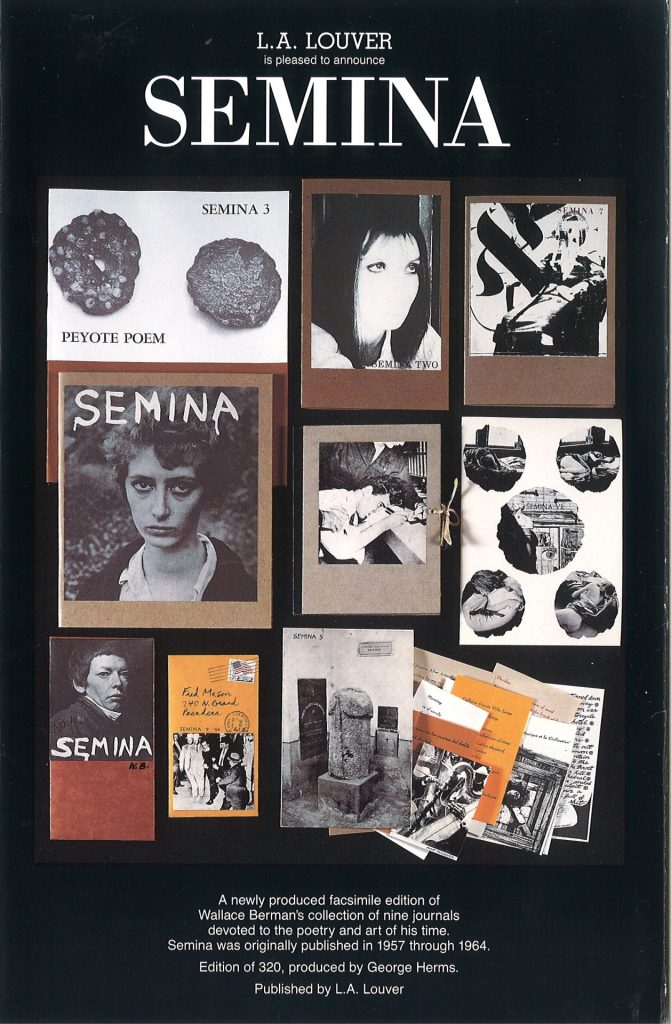
In 1992 L.A. Louver presented the monumental exhibition Poem Makers: Wallace Berman, Jess, and George Herms which showcased the limited-edition facsimile version of Wallace Berman’s Semina; an underground art and poetry publication in nine volumes created by the iconic California assemblage artist of the Beat Generation between 1957 and 1964.
Each of the nine volumes of this handmade and limited-circulation journal consisted of an unbound packet of poems, photographs, and graphics. The assemblage artist printed the journals by hand using a tabletop platen press, individually typesetting the poems and writings within interior pockets together with photographs and original artworks. He then distributed these intimate journals to an ever changing personal mailing list of friends and acquaintances.
The publication focused on representing the artistic and literary avant-garde which resonated within the Beat Generation and the then fledgling and marginalized artistic community in Los Angeles and the Bay Area. Berman selected the contributors which included figures as diverse as William Burroughs, Jean Cocteau, David Meltzer, Philip Lamantia, Robert Duncan, Allen Ginsberg, Michael McClure, and Walter Hopps. The publication also reprinted the works of 20th century literary figures central to the Beat movement such as Antonin Artaud and Herman Hesse. Berman himself also contributed poetry under the pseudonym Pantale Xantos.
Semina’s very first volume landed the artist in hot water when, in 1957, Berman was arrested and convicted for obscenity over the contents of the journal which was on display in a show of his work at Ferus Gallery in Los Angeles. In a note glued to the back of Semina Two, Berman described how the Vice Squad “confiscated Semina One which was exhibited as an important part of a work entitled ‘Temple.’ Brought before the righteous judge Kenneth Holiday [sic], who, taking the allegorical drawing in question out of context declared me guilty of displaying lewd matter. I will continue to print ‘Semina’ from locations other than this city of degenerate angels.” Semina’s itinerant history between Los Angeles and San Francisco thus began until its reconciliation at L.A. Louver three decades later.
The production of the facsimile version by L.A. Louver took four years to complete and was supervised throughout by Berman’s fellow artist and friend, George Herms. Intimately familiar with Berman’s entire oeuvre, Herms painstakingly oversaw the publication to ensure its veracity to the original.
“Poem Makers” contextualized Semina by exhibiting the volumes alongside artworks by George Herms and Jess, as well as original documents, photographs, and archival materials on loan from the Berman and Patricia Jordan archives of the Smithsonian’s Archives of American Art. This four-year collaborative effort was praised by Paul Karlstrom, director of the AAA, who wrote to L.A. Louver after the show’s opening to express that the show was a “highly effective demonstration – among the best [..] ever seen – of what the Archives does and how archival documents relate to and illuminate works of art.”
The success and timeliness of the exhibition was evidenced not only in the resounding praise it received from art writers and critics, and the debate it spurred in the press, but also in the endearing attention and review that it attracted from fellow poets and poetry publications including Vincent Katz (1960- ), Bill Berkson (1939-2016), and Poetry Flash magazine.
A film & poetry evening was also held at Beyond Baroque in tandem with the exhibition, featuring poetry recitations by Michael McClure and David Meltzer, as well as screenings of films by Larry Jordan, Stan Brakhage, and Wallace Berman.
